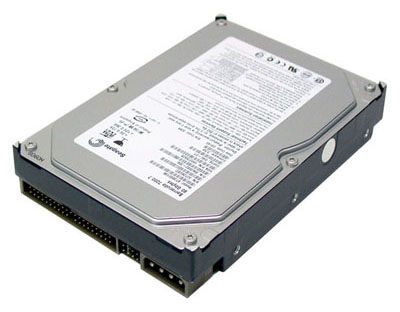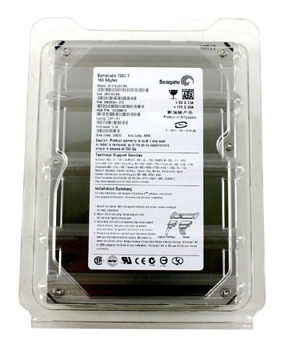Buyer's Guide - Entry Level, October 2004
by Jarred Walton on October 6, 2004 12:05 AM EST- Posted in
- Guides
Hard Drives
As with most of the other options, there are tons of potentially good hard drive choices. The three main factors that influence hard drive performance are the RPM, the amount of cache, and the capacity. While many might insist on a drive with 8 MB of cache, it is not strictly required for the budget segment, and getting a 2 MB cache drive can save you about $10. Getting a 5400 RPM drive instead of a 7200 RPM drive, on the other hand, is not recommended.The question of how much capacity you need is really up to the individual. Some people would never even manage to fill a 20 or 30 GB drive, while for others, even 200 GB may not be enough. These days, the cheapest hard drives still tend to cost about $50, and anything smaller than 40 GB will not be any cheaper. In fact, 80 GB drives are only slightly more expensive than 40 GB drives, and we feel that the extra $10 is worth it to double your capacity.
With most hard drives now spinning at 7200 RPM or faster, noise has become more of a concern. Particularly with an office computer, many people will find high noise levels to be distracting. Earlier 7200 RPM drives have been known to have a high pitch whine. Most companies have now upgraded to the latest spindle technology known as fluid dynamic ball bearings, which help to all but eliminate the noise of the hard drive. Many Western Digital Caviar and Maxtor drives use the older bearings and so, unless noise does not bother you, we recommend that you search out a drive that uses the fluid dynamic bearings. This is available on Hitachi, Maxtor, Samsung, Seagate, and Western Digital drives now, but take some time to make certain that it is on the model that you are purchasing.
One trend that we are happy to see is the return of longer warranties. For a while, many companies were shifting to 1-year warranties. Now, most of them have returned to 3- or even 5-year warranties on their drives. Seagate has led the way with a standard 5-year warranty on all of their models, including previously purchased drives! Others have only increased their warranty on current models. Just remember that the warranty only covers the physical hard drive, so you still need to make backups of your important files.
The final topic relating to hard drive choice is the interface. Parallel ATA - also called IDE or EIDE - has been around for a long time, so it tends to be slightly cheaper. The budget office motherboard that we recommended does not support anything else, but the gaming motherboard offers support for up to two Serial ATA connections. There is little to no difference in real world performance between the interfaces, at least in the budget segment, but SATA does use a thinner cable that is easier to work with. All things being equal, we would prefer a SATA drive over a PATA drive, and we would even be willing to pay a little more for it if necessary.

Office Hard Drive Recommendation: Seagate 80 GB 7200 RPM 8MB PATA
Price: $67 shipped
With all the considerations listed above, it is difficult to argue with the choice of a Seagate hard drive. You get the full five-year warranty (two years more than most of the competition), quiet operation, good performance, and plenty of storage. You could save a few dollars by choosing some alternative, but it just does not make a lot of sense. Should you need more storage space, models with 120 GB and 160 GB are available and have a lower cost per GB, but 80 GB should be plenty for even the most demanding office work.

Gaming Hard Drive Recommendation: Seagate 160 GB 7200 RPM 8MB SATA
Price: $107 shipped
Our recommendation for budget gamers remains with Seagate, due to their impressive set of features and reliability. The difference is that we have chosen to go with a SATA drive instead of PATA, and we have increased the recommended capacity to 160 GB. That may seem like overkill, but when you consider that Far Cry, Unreal Tournament 2004, and Doom 3 all require about 4 GB of hard drive space - and that's without any of the extra content that you can find online - it is very easy to run out of storage for your games. If you uninstall games that you are not currently playing, you can get around this potential difficulty, but that is not the most convenient of solutions. You can always downgrade to a 120 GB or 80 GB drive if you disagree. The cost per GB of an 80 GB SATA drive is 89 cents, while the cost per GB of the 160 GB drive is 71 cents. If you can afford it, you get double your storage space for about a 50% price increase.










53 Comments
View All Comments
kmmatney - Wednesday, October 6, 2004 - link
We are going completely small form factor at my office, using either the ASUS Terminator or, lately, ASUS T2-P with Celeron-D. They've all worked great, and no problems using on-board graphics.The ASUS Terminator + Duron is simply an incredible value. The ASUS T2-R is also nice, with ATI Radeon 9100 graophics.
kherman - Wednesday, October 6, 2004 - link
kherman - Wednesday, October 6, 2004 - link
Left kinda confused. I see alot of areas I simply didn't like. In particular, for a true Office rig, where data intergretty is VERY important, I'd suggest 2 hard drives and a software RAID solution. Same total cost for hard drives, but it's justfied in terms of budget. Spend the same amount. for gaming, go for fast loading. For office, go for redundancy. The Office rig would actually have more alloted to the hard drive, but isn't that the critical component in an office rig?I say this every time I see a write up. You really need to start mentioning it, even if it's simpyl an alternative office solution that costs more. Most people using a PC for home office use, don't have a server running RAID 5 available and it almost seems as though it's an assumption.
Other than this, I loved that article. Also, for home office, I can't see recomending 17" monitors. You need to generally run higher resolution and see more of the screen to be efficient in a home office.
To be honest, I have to say that "a "budget rig" for office shouldn't be much cheaper than he gaming rig. Monitors and redundancy are important factors here where gaming rigs need a killer video card.
Please consider this in the future.
boomerang - Wednesday, October 6, 2004 - link
Very happy with the more in-depth explanations and choices given in the guide. I very much depend on these guides when building systems.You are to be commended for a job well done!
iversonyin - Wednesday, October 6, 2004 - link
since we in the entry level budget, why not get a generic case+ PS. generic case usually got for ~$35i would not run XP with 256 MB RAM even its only for office use. IMO
PrinceGaz - Wednesday, October 6, 2004 - link
On the last page in the Additional Alternatives table, the Power Supply Upgrade has the wrong item name.Iger - Wednesday, October 6, 2004 - link
Thanks for the nice guide, I love explanations too :)About monitors - there actually are Samsung 795 DF ones, which handle 1280x1024@75 for a few more $ :)
Gholam - Wednesday, October 6, 2004 - link
$14, Bayfield is just way too expensive - why not use a D865GVHZ if you're determined to go Intel?Gholam - Wednesday, October 6, 2004 - link
$14, Bayfield is just way too expensive - why not use a D865GVHZ if you're determined to go Intel?Scarceas - Wednesday, October 6, 2004 - link
I've had seen at least one business app that didn't run right on an nForce motherboard. It was wierd.Anyway, I never seem to have any trouble with stability or configuration when using an Intel-branded motherboard with an Intel CPU.
It does cost a bit more, but the in the total cost of ownership equation, the hardware itself is definitely not the largest factor, especially on a budget near this one.
The previously mentioned application is a good case in point: the money saved in hardware was easily ate up in service/support to troubleshoot the program.
I like the Intel D865GBFL motherboard, and if you're going budget, a Celeron D 320 will fit nicely ($165 shipped from Newegg).
In an office environment, the performance delta is not so critical, and I don't mind spending $35 more if it reduces support issues.
Just something to conside...